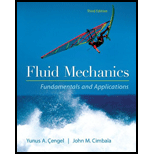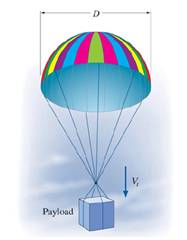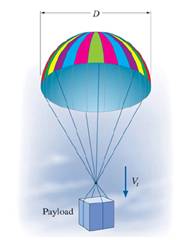
A lightweight parachute is being designed for military use (Fig. P7-42E). Its diameter D is 20 ft and the total weight W of the falling payload, parachute, and equipment is 145 lbf. The design terminal settling speed Vt, of the parachute at this weight is 18 ft/s. A one-twelfth scale model of the parachute is tested m a wind tunnel. The wind tunnel temperature and pressure are the same as those of the prototype, namely 60°F and standard atmospheric pressure, (a) Calculate the drag coefficient of the prototype. (Hint: At terminal settling speed, weight is balanced by aerodynamic drag.) (b) At what wind tunnel speed should the wind tunnel be run in order to achieve dynamic similarity? (c) Estimate the aerodynamic drag of the model parachute in the wind tunnel (in lbf)
(a)
The drag coefficient of the prototype.
Answer to Problem 40EP
The drag coefficient of the prototype is1.202.
Explanation of Solution
Given information:
A lightweight parachute is being designed for military use.
Diameter = 20 ft
Total weight = 145 lbf
Design terminal speed (Vt) = 18 ft/s

Hint:
At terminal settling speed, weight is balanced by aerodynamic drag.
Drag coefficient is given as,
Where,
On substituting the values,
So, the value of drag coefficient is 1.202
(b)
The speed of wind tunnel to achieve dynamic similarities.
Answer to Problem 40EP
The air speed to run wind tunnel to achieve dynamic similarity is 216 ft/s.
Explanation of Solution
Given information:
A lightweight parachute is being designed for military use.
Diameter = 20 ft
Total weight = 145 lbf
Design terminal speed (Vt) = 18 ft/s

For similarity of model and prototype can be understood by calculating Reynold's number of both.
For dynamic similarity of model and prototype,
On rearranging the equation (i) for speed of wind tunnel,
On rearranging,
On substituting the values,
Thus, the air speed to run wind tunnel to achieve dynamic similarity is 216 ft/s.
(c)
The aerodynamics drag of the model parachute in the wind tunnel (in lbf).
Answer to Problem 40EP
The aerodynamics drag of the model parachute in the wind tunnel is 145lbf.
Explanation of Solution
Given information:
A lightweight parachute is being designed for military use.
Diameter = 20 ft
Total weight = 145 lbf
Design terminal speed (Vt) = 18 ft/s

For similarity of model and prototype can be understood by calculating Reynold's number of both.
For similarity of model and prototype,
Reynolds number is similar for both model and prototype. Thus, drag force of prototype and model will also be equal.
Now,
Drag force of prototype and model will be same. Due to following reasons: -
- The acting fluid is same
- Dynamic similarity is present
- Same viscosity ratio of model and prototype.
Thus, the aerodynamics drag of the model parachute in the wind tunnel is 145 lbf.
Want to see more full solutions like this?
Chapter 7 Solutions
Fluid Mechanics Fundamentals And Applications
- When a sphere falls freely through a homogeneous fluid, it reaches a terminal velocity at which the weight of the sphere is balanced by the buoyant force and the frictional resistance of the fluid. Make a dimensional analysis of this problem and indicate how experimental data for this problem could be correlated. Neglect compressibility effects and the influence of surface roughness.arrow_forwardGive Justification for performing a geometrically scaled model rather than the full-scale prototype in the technique of dimensional analysis and similarity.arrow_forwardThe drag coefficient in aircraft industry affected by some parameters which are thespeed of plane (v), the plane length (L), the air density (ρ), the air dynamic viscosity(μ), and speed of sound (a). By using dimensional analysis, identify two non-dimensionnumbers in which the drag coefficient is a function of them and explain how these twowill effect on drag coefficient.arrow_forward
- A solid cylinder of diameter D , length L , and density ρ sfalls due to gravity inside a tube of diameter D 0 . The clearance,D 0 - D <<, D , is fi lled with fl uid of density ρ andviscosity μ . Neglect the air above and below the cylinder.Derive a formula for the terminal fall velocity of the cylinder.Apply your formula to the case of a steel cylinder,D = 2 cm, D 0 = 2.04 cm, L = 15 cm, with a film of SAE30 oil at 20 ° C.arrow_forwardList and describe the three necessary conditions for complete similarity between a model and a prototype.arrow_forwardIn making a dimensional analysis, what rules do you followfor choosing your scaling variables?arrow_forward
- A stirrer is used to mix chemicals in a tank let tank diameter Dtank and average liquid depth htank. The shaft power W . supplied to the stirrer blades is a function of stirrer diameter D, liquid density ? ,liquidviscosity ? , and the angular velocity ? of the spinning blades.Use the method of repeating variables to generate a dimensionless relationship between these parameters. Show all your work and be sure to identify your Π groups, modifying them as necessary.arrow_forwardUse the first principle (dimensional analysis) to generate a dimensionless relationship for the x-component of fluid velocity u as a function of fluid viscosity μ, top plate speed v, distance h, fluid density ρ, and distance y.arrow_forwardConsider a boundary layer growing along a thin flat plate. This problem involves the following parameters: boundary layer thickness ? , downstream distance x, free-stream velocity V, fluid density ? , and fluid viscosity ? . The number of primary dimensions represented in this problem is (a) 1 (b) 2 (c) 3 (d ) 4 (e) 5arrow_forward
- The power P generated by a certain windmill design dependson its diameter D , the air density ρ , the wind velocity V , therotation rate Ω , and the number of blades n . ( a ) Write this relationship in dimensionless form. A model windmill, of diameter50 cm, develops 2.7 kW at sea level when V = 40 m/s andwhen rotating at 4800 r/min. ( b ) What power will be developedby a geometrically and dynamically similar prototype, ofdiameter 5 m, in winds of 12 m/s at 2000 m standard altitude?( c ) What is the appropriate rotation rate of the prototype?arrow_forwardThe variation of fluid pressure with height is described by the differential equation: dp/dz = - density *g Here, p is specific density and g is the local acceleration of gravity. For an ideal gas, p = M PIRT, where M is molar mass and R is the universal gas constant. Modeling the atmosphere as an isothermal column of ideal gas at 283.15 K (lO°C), estimate the ambient pressure in Denver, where z = l(mi1e) relative to sea level. For air, take M = 29 g molP1; values of R are given in App. A.arrow_forwardThe speed of sound c in an ideal gas is known to be a function of absolute temperature T, universal ideal gas constant Ru, molar mass (molecular weight) M of the gas, and ratio of specific heats k. Showing all your work, use dimensional analysis to find the functional relationship between these parameters.arrow_forward
 Principles of Heat Transfer (Activate Learning wi...Mechanical EngineeringISBN:9781305387102Author:Kreith, Frank; Manglik, Raj M.Publisher:Cengage Learning
Principles of Heat Transfer (Activate Learning wi...Mechanical EngineeringISBN:9781305387102Author:Kreith, Frank; Manglik, Raj M.Publisher:Cengage Learning
